Steve Jobs' Leadership: A Path-Goal Theory Based Analysis
VerifiedAdded on 2023/06/03
|9
|1920
|50
Report
AI Summary
This report provides a critical analysis of the Path-Goal Theory of leadership, examining its various components and how they relate to effective leadership behavior. It uses the example of Steve Jobs, the former CEO and founder of Apple, to illustrate these concepts. The report explores Steve Jobs' leadership style and behavior towards employees, assessing its effectiveness in light of Path-Goal Theory. It discusses how Path-Goal Theory can influence leadership styles and identifies instances where Steve Jobs' leadership may have deviated from the principles of the theory. The analysis considers the impact of his autocratic style on employee satisfaction and organizational operations, concluding that while his leadership fostered innovation, his neglect of employee needs could pose challenges for the company's future.
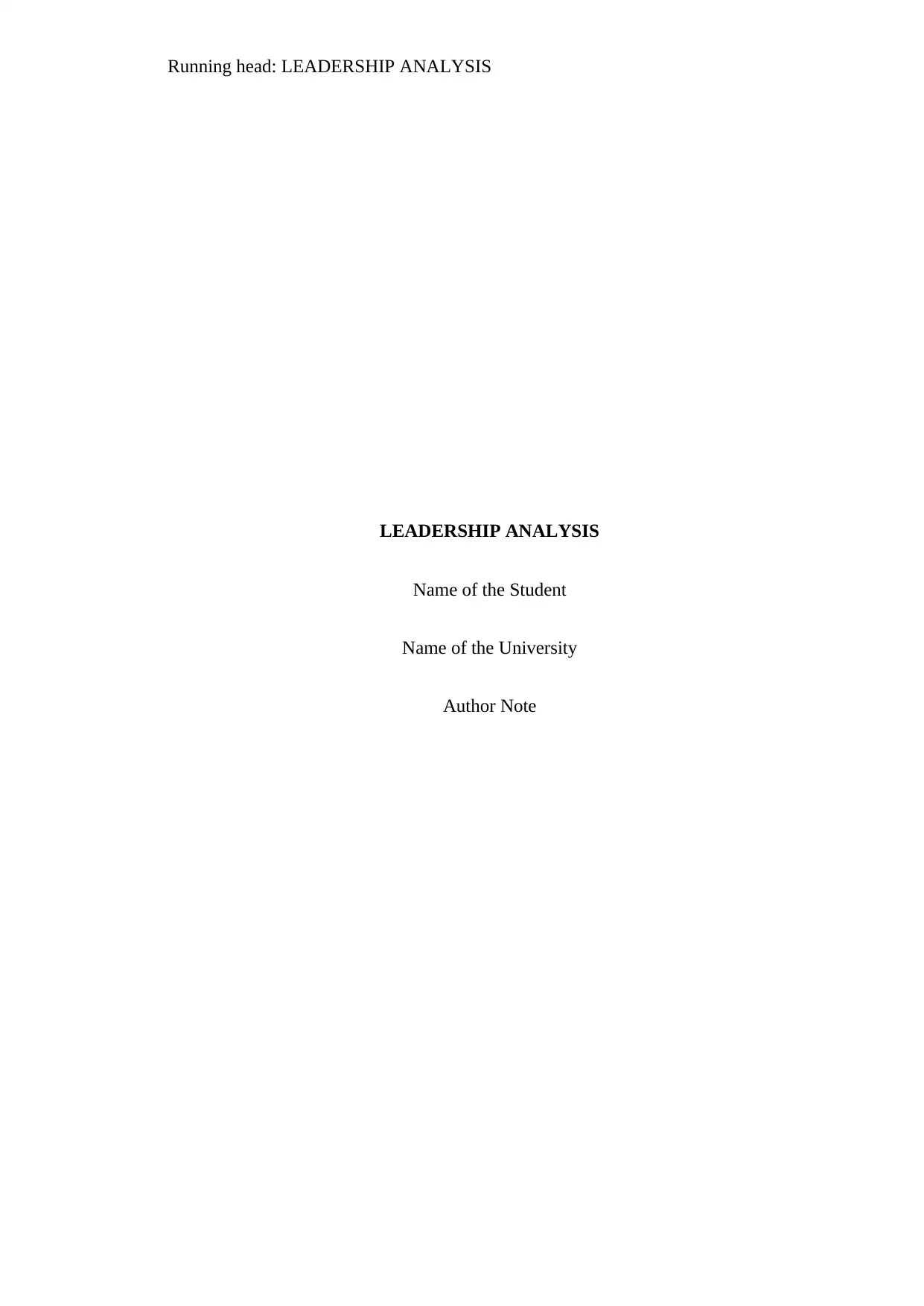
Running head: LEADERSHIP ANALYSIS
LEADERSHIP ANALYSIS
Name of the Student
Name of the University
Author Note
LEADERSHIP ANALYSIS
Name of the Student
Name of the University
Author Note
Paraphrase This Document
Need a fresh take? Get an instant paraphrase of this document with our AI Paraphraser
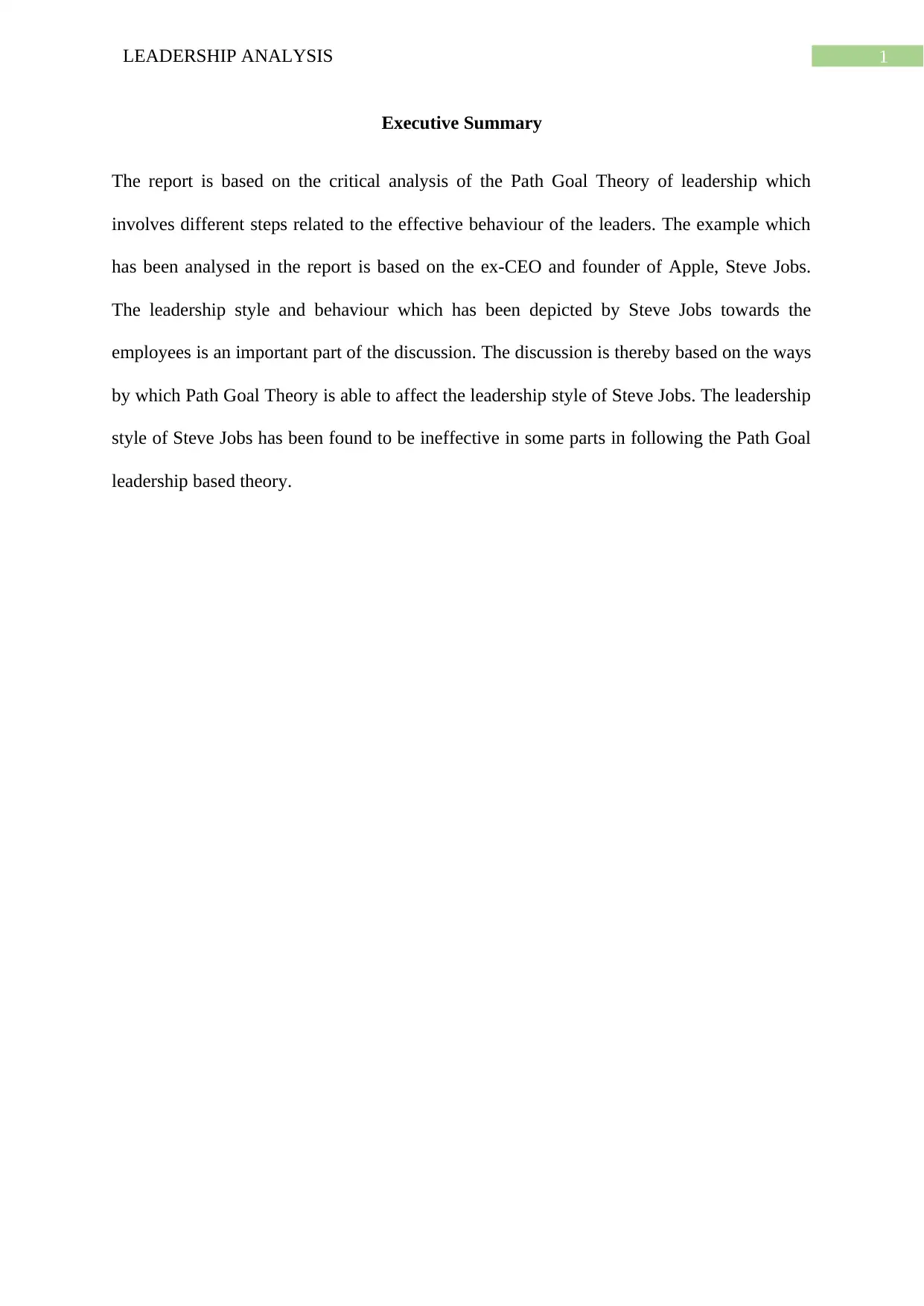
1LEADERSHIP ANALYSIS
Executive Summary
The report is based on the critical analysis of the Path Goal Theory of leadership which
involves different steps related to the effective behaviour of the leaders. The example which
has been analysed in the report is based on the ex-CEO and founder of Apple, Steve Jobs.
The leadership style and behaviour which has been depicted by Steve Jobs towards the
employees is an important part of the discussion. The discussion is thereby based on the ways
by which Path Goal Theory is able to affect the leadership style of Steve Jobs. The leadership
style of Steve Jobs has been found to be ineffective in some parts in following the Path Goal
leadership based theory.
Executive Summary
The report is based on the critical analysis of the Path Goal Theory of leadership which
involves different steps related to the effective behaviour of the leaders. The example which
has been analysed in the report is based on the ex-CEO and founder of Apple, Steve Jobs.
The leadership style and behaviour which has been depicted by Steve Jobs towards the
employees is an important part of the discussion. The discussion is thereby based on the ways
by which Path Goal Theory is able to affect the leadership style of Steve Jobs. The leadership
style of Steve Jobs has been found to be ineffective in some parts in following the Path Goal
leadership based theory.
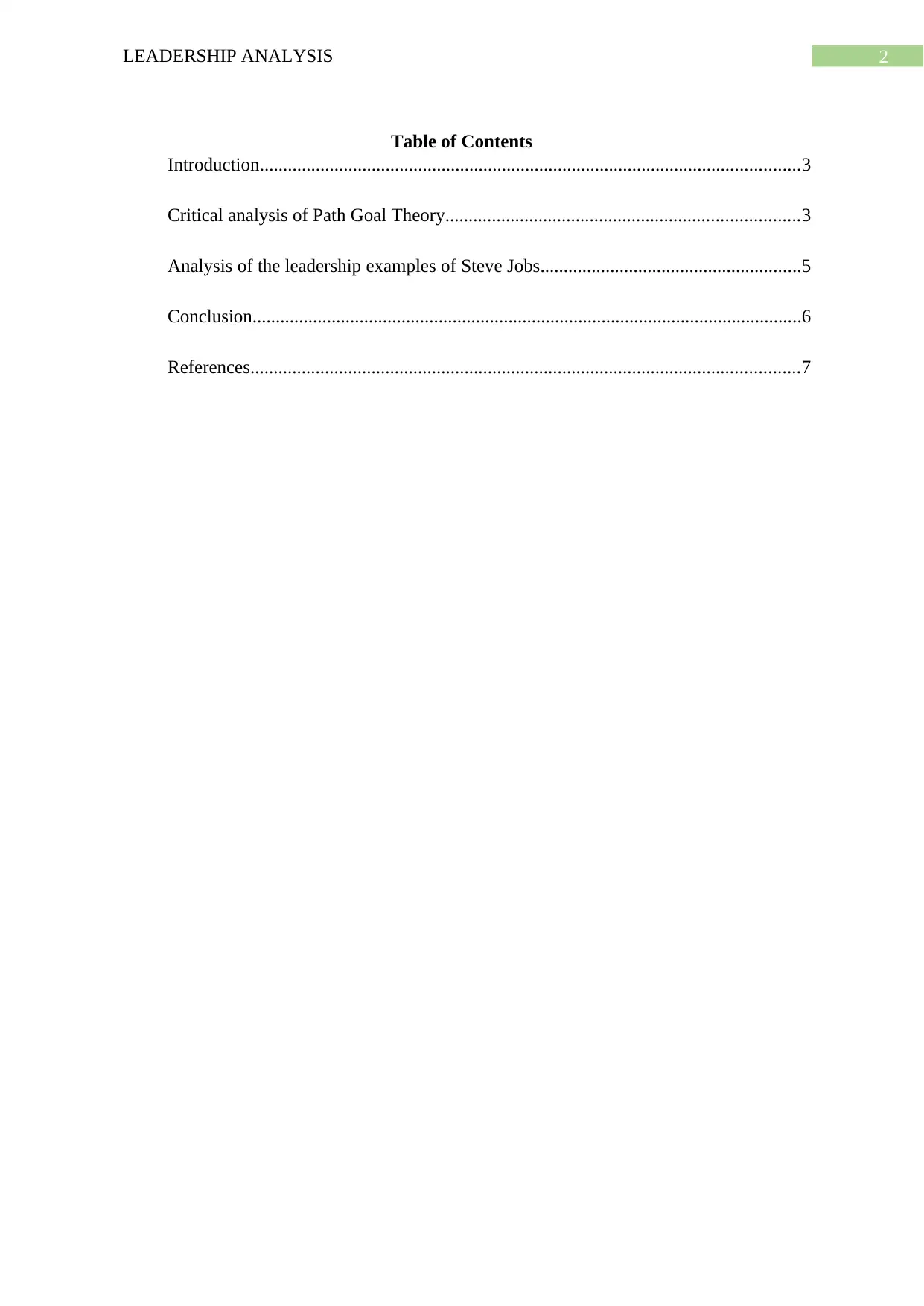
2LEADERSHIP ANALYSIS
Table of Contents
Introduction....................................................................................................................3
Critical analysis of Path Goal Theory............................................................................3
Analysis of the leadership examples of Steve Jobs........................................................5
Conclusion......................................................................................................................6
References......................................................................................................................7
Table of Contents
Introduction....................................................................................................................3
Critical analysis of Path Goal Theory............................................................................3
Analysis of the leadership examples of Steve Jobs........................................................5
Conclusion......................................................................................................................6
References......................................................................................................................7
⊘ This is a preview!⊘
Do you want full access?
Subscribe today to unlock all pages.

Trusted by 1+ million students worldwide
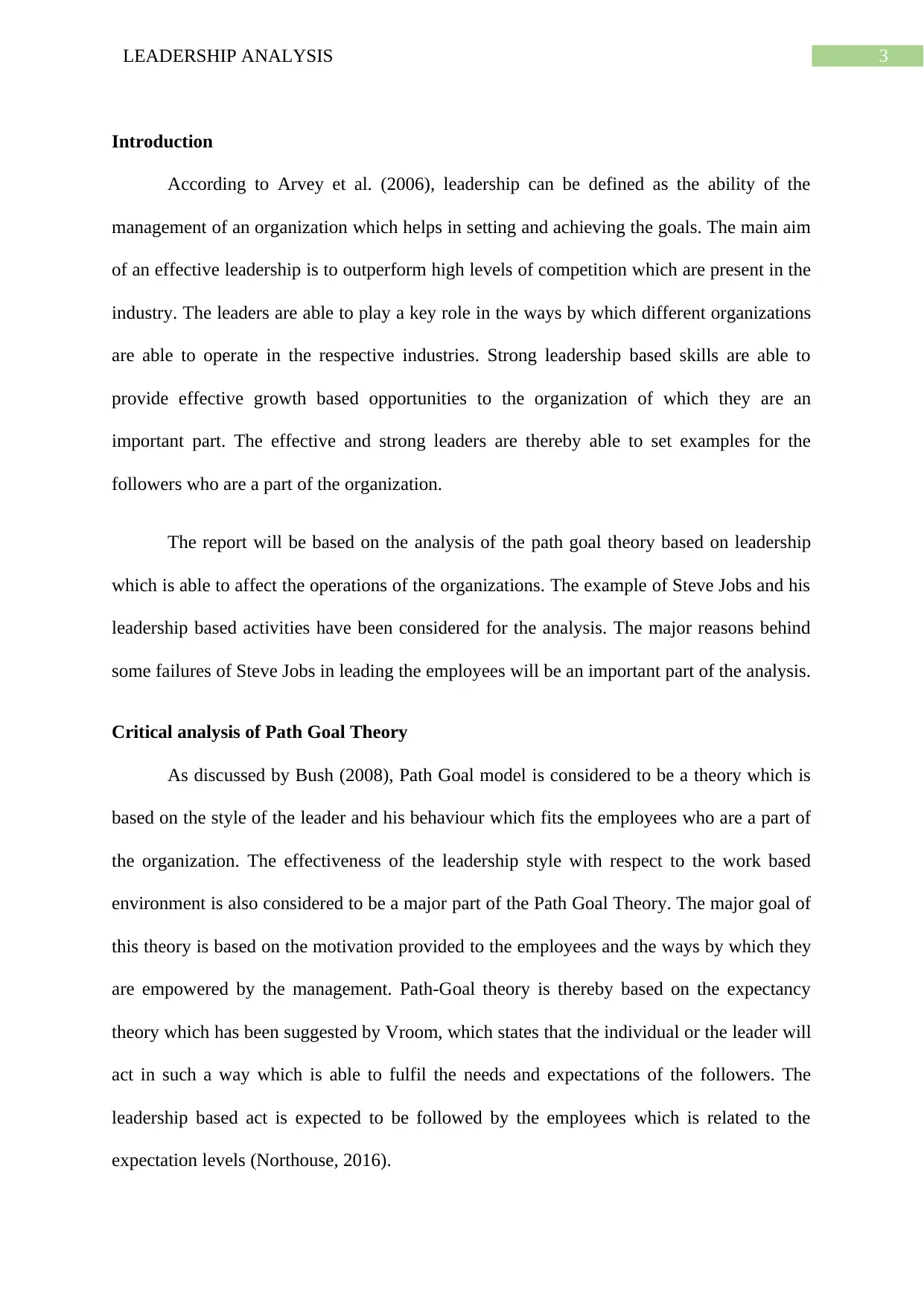
3LEADERSHIP ANALYSIS
Introduction
According to Arvey et al. (2006), leadership can be defined as the ability of the
management of an organization which helps in setting and achieving the goals. The main aim
of an effective leadership is to outperform high levels of competition which are present in the
industry. The leaders are able to play a key role in the ways by which different organizations
are able to operate in the respective industries. Strong leadership based skills are able to
provide effective growth based opportunities to the organization of which they are an
important part. The effective and strong leaders are thereby able to set examples for the
followers who are a part of the organization.
The report will be based on the analysis of the path goal theory based on leadership
which is able to affect the operations of the organizations. The example of Steve Jobs and his
leadership based activities have been considered for the analysis. The major reasons behind
some failures of Steve Jobs in leading the employees will be an important part of the analysis.
Critical analysis of Path Goal Theory
As discussed by Bush (2008), Path Goal model is considered to be a theory which is
based on the style of the leader and his behaviour which fits the employees who are a part of
the organization. The effectiveness of the leadership style with respect to the work based
environment is also considered to be a major part of the Path Goal Theory. The major goal of
this theory is based on the motivation provided to the employees and the ways by which they
are empowered by the management. Path-Goal theory is thereby based on the expectancy
theory which has been suggested by Vroom, which states that the individual or the leader will
act in such a way which is able to fulfil the needs and expectations of the followers. The
leadership based act is expected to be followed by the employees which is related to the
expectation levels (Northouse, 2016).
Introduction
According to Arvey et al. (2006), leadership can be defined as the ability of the
management of an organization which helps in setting and achieving the goals. The main aim
of an effective leadership is to outperform high levels of competition which are present in the
industry. The leaders are able to play a key role in the ways by which different organizations
are able to operate in the respective industries. Strong leadership based skills are able to
provide effective growth based opportunities to the organization of which they are an
important part. The effective and strong leaders are thereby able to set examples for the
followers who are a part of the organization.
The report will be based on the analysis of the path goal theory based on leadership
which is able to affect the operations of the organizations. The example of Steve Jobs and his
leadership based activities have been considered for the analysis. The major reasons behind
some failures of Steve Jobs in leading the employees will be an important part of the analysis.
Critical analysis of Path Goal Theory
As discussed by Bush (2008), Path Goal model is considered to be a theory which is
based on the style of the leader and his behaviour which fits the employees who are a part of
the organization. The effectiveness of the leadership style with respect to the work based
environment is also considered to be a major part of the Path Goal Theory. The major goal of
this theory is based on the motivation provided to the employees and the ways by which they
are empowered by the management. Path-Goal theory is thereby based on the expectancy
theory which has been suggested by Vroom, which states that the individual or the leader will
act in such a way which is able to fulfil the needs and expectations of the followers. The
leadership based act is expected to be followed by the employees which is related to the
expectation levels (Northouse, 2016).
Paraphrase This Document
Need a fresh take? Get an instant paraphrase of this document with our AI Paraphraser
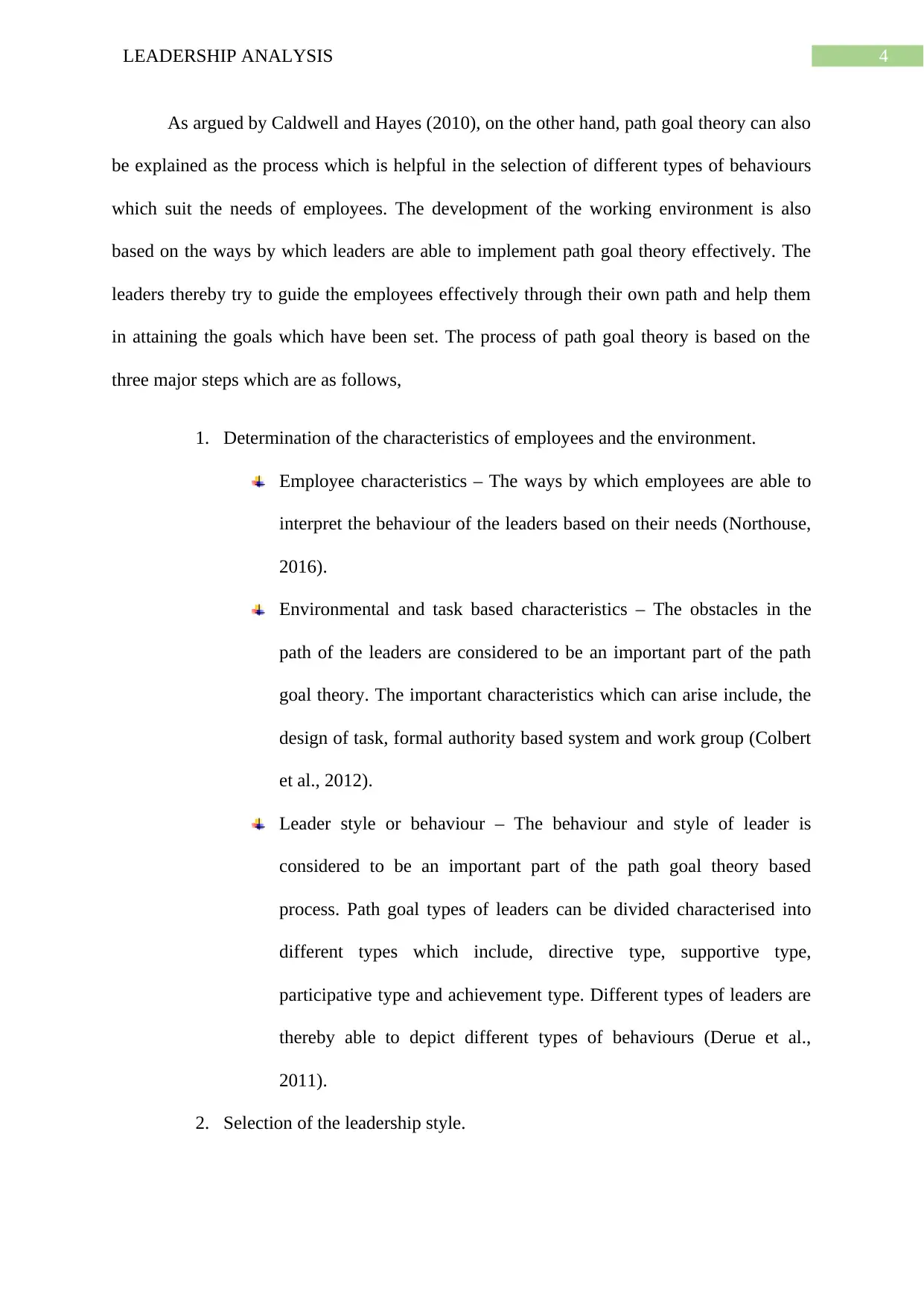
4LEADERSHIP ANALYSIS
As argued by Caldwell and Hayes (2010), on the other hand, path goal theory can also
be explained as the process which is helpful in the selection of different types of behaviours
which suit the needs of employees. The development of the working environment is also
based on the ways by which leaders are able to implement path goal theory effectively. The
leaders thereby try to guide the employees effectively through their own path and help them
in attaining the goals which have been set. The process of path goal theory is based on the
three major steps which are as follows,
1. Determination of the characteristics of employees and the environment.
Employee characteristics – The ways by which employees are able to
interpret the behaviour of the leaders based on their needs (Northouse,
2016).
Environmental and task based characteristics – The obstacles in the
path of the leaders are considered to be an important part of the path
goal theory. The important characteristics which can arise include, the
design of task, formal authority based system and work group (Colbert
et al., 2012).
Leader style or behaviour – The behaviour and style of leader is
considered to be an important part of the path goal theory based
process. Path goal types of leaders can be divided characterised into
different types which include, directive type, supportive type,
participative type and achievement type. Different types of leaders are
thereby able to depict different types of behaviours (Derue et al.,
2011).
2. Selection of the leadership style.
As argued by Caldwell and Hayes (2010), on the other hand, path goal theory can also
be explained as the process which is helpful in the selection of different types of behaviours
which suit the needs of employees. The development of the working environment is also
based on the ways by which leaders are able to implement path goal theory effectively. The
leaders thereby try to guide the employees effectively through their own path and help them
in attaining the goals which have been set. The process of path goal theory is based on the
three major steps which are as follows,
1. Determination of the characteristics of employees and the environment.
Employee characteristics – The ways by which employees are able to
interpret the behaviour of the leaders based on their needs (Northouse,
2016).
Environmental and task based characteristics – The obstacles in the
path of the leaders are considered to be an important part of the path
goal theory. The important characteristics which can arise include, the
design of task, formal authority based system and work group (Colbert
et al., 2012).
Leader style or behaviour – The behaviour and style of leader is
considered to be an important part of the path goal theory based
process. Path goal types of leaders can be divided characterised into
different types which include, directive type, supportive type,
participative type and achievement type. Different types of leaders are
thereby able to depict different types of behaviours (Derue et al.,
2011).
2. Selection of the leadership style.
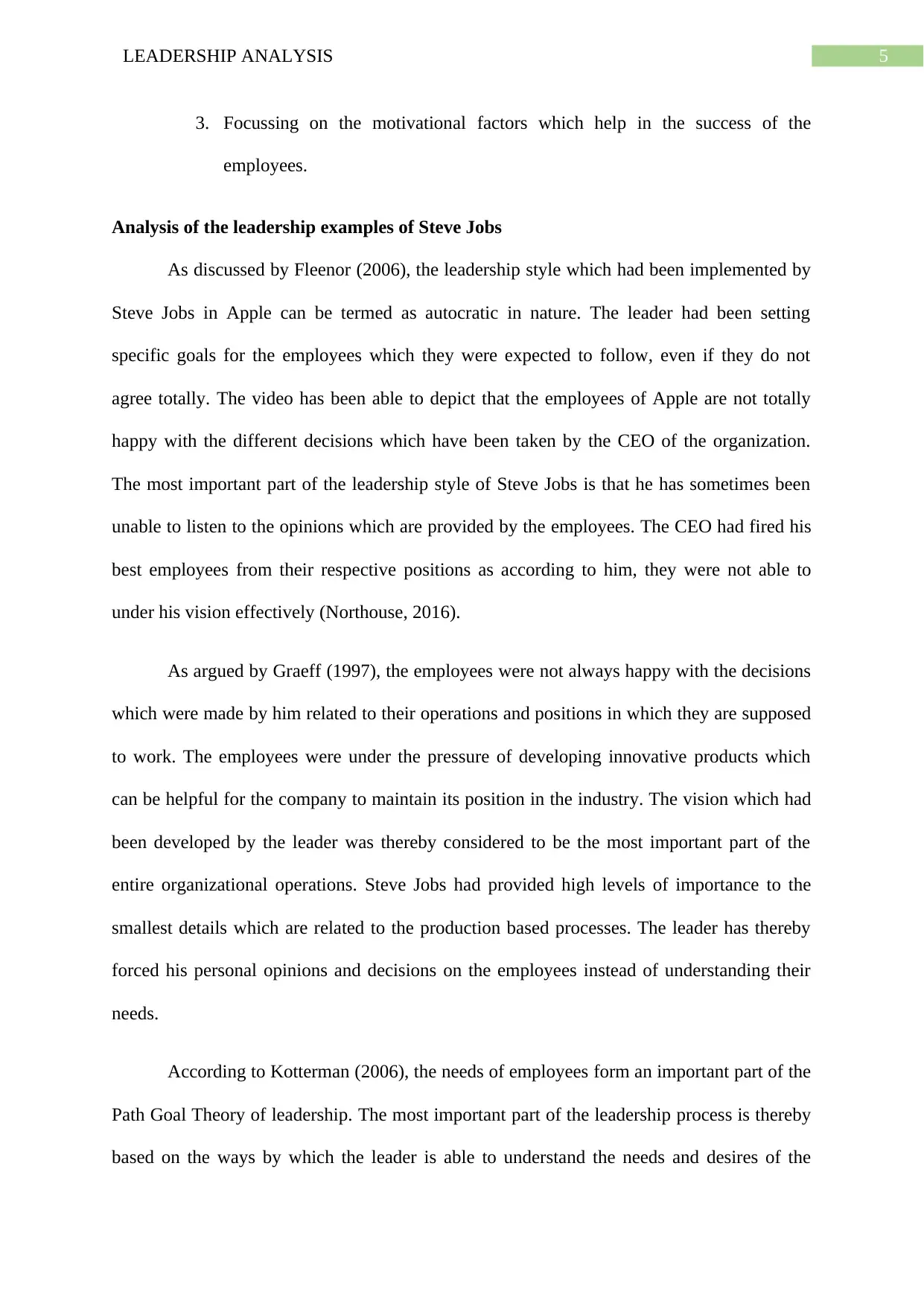
5LEADERSHIP ANALYSIS
3. Focussing on the motivational factors which help in the success of the
employees.
Analysis of the leadership examples of Steve Jobs
As discussed by Fleenor (2006), the leadership style which had been implemented by
Steve Jobs in Apple can be termed as autocratic in nature. The leader had been setting
specific goals for the employees which they were expected to follow, even if they do not
agree totally. The video has been able to depict that the employees of Apple are not totally
happy with the different decisions which have been taken by the CEO of the organization.
The most important part of the leadership style of Steve Jobs is that he has sometimes been
unable to listen to the opinions which are provided by the employees. The CEO had fired his
best employees from their respective positions as according to him, they were not able to
under his vision effectively (Northouse, 2016).
As argued by Graeff (1997), the employees were not always happy with the decisions
which were made by him related to their operations and positions in which they are supposed
to work. The employees were under the pressure of developing innovative products which
can be helpful for the company to maintain its position in the industry. The vision which had
been developed by the leader was thereby considered to be the most important part of the
entire organizational operations. Steve Jobs had provided high levels of importance to the
smallest details which are related to the production based processes. The leader has thereby
forced his personal opinions and decisions on the employees instead of understanding their
needs.
According to Kotterman (2006), the needs of employees form an important part of the
Path Goal Theory of leadership. The most important part of the leadership process is thereby
based on the ways by which the leader is able to understand the needs and desires of the
3. Focussing on the motivational factors which help in the success of the
employees.
Analysis of the leadership examples of Steve Jobs
As discussed by Fleenor (2006), the leadership style which had been implemented by
Steve Jobs in Apple can be termed as autocratic in nature. The leader had been setting
specific goals for the employees which they were expected to follow, even if they do not
agree totally. The video has been able to depict that the employees of Apple are not totally
happy with the different decisions which have been taken by the CEO of the organization.
The most important part of the leadership style of Steve Jobs is that he has sometimes been
unable to listen to the opinions which are provided by the employees. The CEO had fired his
best employees from their respective positions as according to him, they were not able to
under his vision effectively (Northouse, 2016).
As argued by Graeff (1997), the employees were not always happy with the decisions
which were made by him related to their operations and positions in which they are supposed
to work. The employees were under the pressure of developing innovative products which
can be helpful for the company to maintain its position in the industry. The vision which had
been developed by the leader was thereby considered to be the most important part of the
entire organizational operations. Steve Jobs had provided high levels of importance to the
smallest details which are related to the production based processes. The leader has thereby
forced his personal opinions and decisions on the employees instead of understanding their
needs.
According to Kotterman (2006), the needs of employees form an important part of the
Path Goal Theory of leadership. The most important part of the leadership process is thereby
based on the ways by which the leader is able to understand the needs and desires of the
⊘ This is a preview!⊘
Do you want full access?
Subscribe today to unlock all pages.

Trusted by 1+ million students worldwide
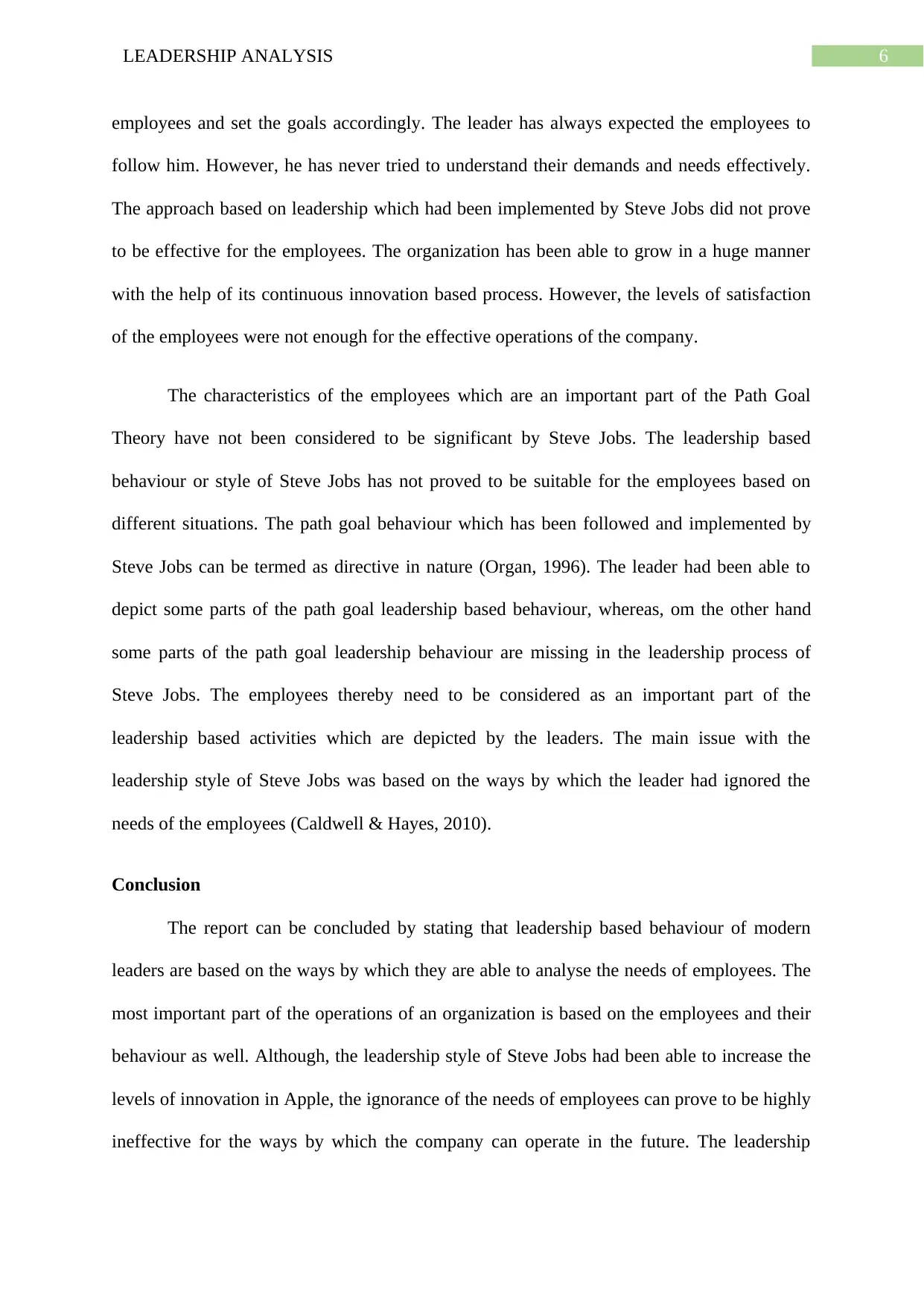
6LEADERSHIP ANALYSIS
employees and set the goals accordingly. The leader has always expected the employees to
follow him. However, he has never tried to understand their demands and needs effectively.
The approach based on leadership which had been implemented by Steve Jobs did not prove
to be effective for the employees. The organization has been able to grow in a huge manner
with the help of its continuous innovation based process. However, the levels of satisfaction
of the employees were not enough for the effective operations of the company.
The characteristics of the employees which are an important part of the Path Goal
Theory have not been considered to be significant by Steve Jobs. The leadership based
behaviour or style of Steve Jobs has not proved to be suitable for the employees based on
different situations. The path goal behaviour which has been followed and implemented by
Steve Jobs can be termed as directive in nature (Organ, 1996). The leader had been able to
depict some parts of the path goal leadership based behaviour, whereas, om the other hand
some parts of the path goal leadership behaviour are missing in the leadership process of
Steve Jobs. The employees thereby need to be considered as an important part of the
leadership based activities which are depicted by the leaders. The main issue with the
leadership style of Steve Jobs was based on the ways by which the leader had ignored the
needs of the employees (Caldwell & Hayes, 2010).
Conclusion
The report can be concluded by stating that leadership based behaviour of modern
leaders are based on the ways by which they are able to analyse the needs of employees. The
most important part of the operations of an organization is based on the employees and their
behaviour as well. Although, the leadership style of Steve Jobs had been able to increase the
levels of innovation in Apple, the ignorance of the needs of employees can prove to be highly
ineffective for the ways by which the company can operate in the future. The leadership
employees and set the goals accordingly. The leader has always expected the employees to
follow him. However, he has never tried to understand their demands and needs effectively.
The approach based on leadership which had been implemented by Steve Jobs did not prove
to be effective for the employees. The organization has been able to grow in a huge manner
with the help of its continuous innovation based process. However, the levels of satisfaction
of the employees were not enough for the effective operations of the company.
The characteristics of the employees which are an important part of the Path Goal
Theory have not been considered to be significant by Steve Jobs. The leadership based
behaviour or style of Steve Jobs has not proved to be suitable for the employees based on
different situations. The path goal behaviour which has been followed and implemented by
Steve Jobs can be termed as directive in nature (Organ, 1996). The leader had been able to
depict some parts of the path goal leadership based behaviour, whereas, om the other hand
some parts of the path goal leadership behaviour are missing in the leadership process of
Steve Jobs. The employees thereby need to be considered as an important part of the
leadership based activities which are depicted by the leaders. The main issue with the
leadership style of Steve Jobs was based on the ways by which the leader had ignored the
needs of the employees (Caldwell & Hayes, 2010).
Conclusion
The report can be concluded by stating that leadership based behaviour of modern
leaders are based on the ways by which they are able to analyse the needs of employees. The
most important part of the operations of an organization is based on the employees and their
behaviour as well. Although, the leadership style of Steve Jobs had been able to increase the
levels of innovation in Apple, the ignorance of the needs of employees can prove to be highly
ineffective for the ways by which the company can operate in the future. The leadership
Paraphrase This Document
Need a fresh take? Get an instant paraphrase of this document with our AI Paraphraser
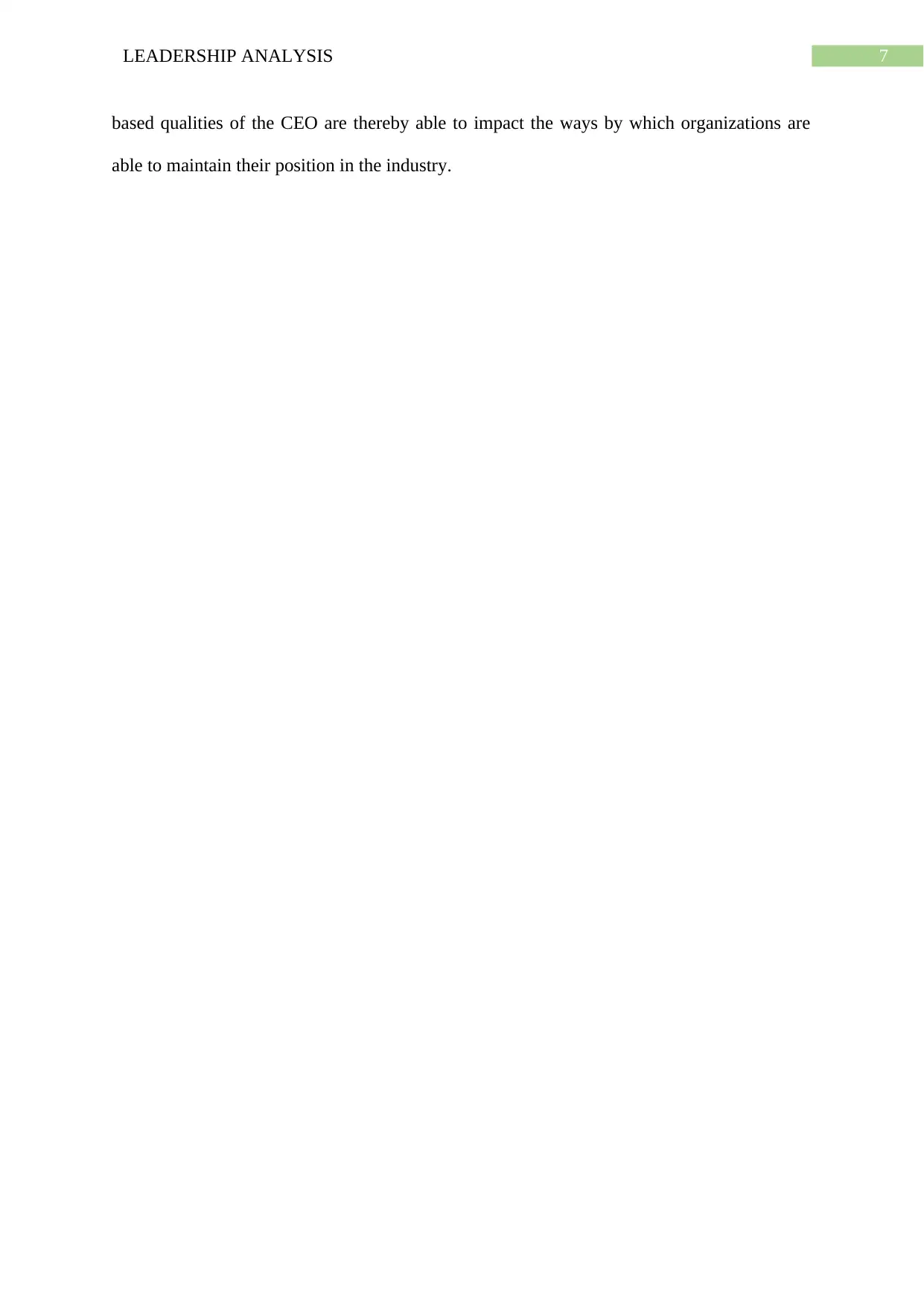
7LEADERSHIP ANALYSIS
based qualities of the CEO are thereby able to impact the ways by which organizations are
able to maintain their position in the industry.
based qualities of the CEO are thereby able to impact the ways by which organizations are
able to maintain their position in the industry.
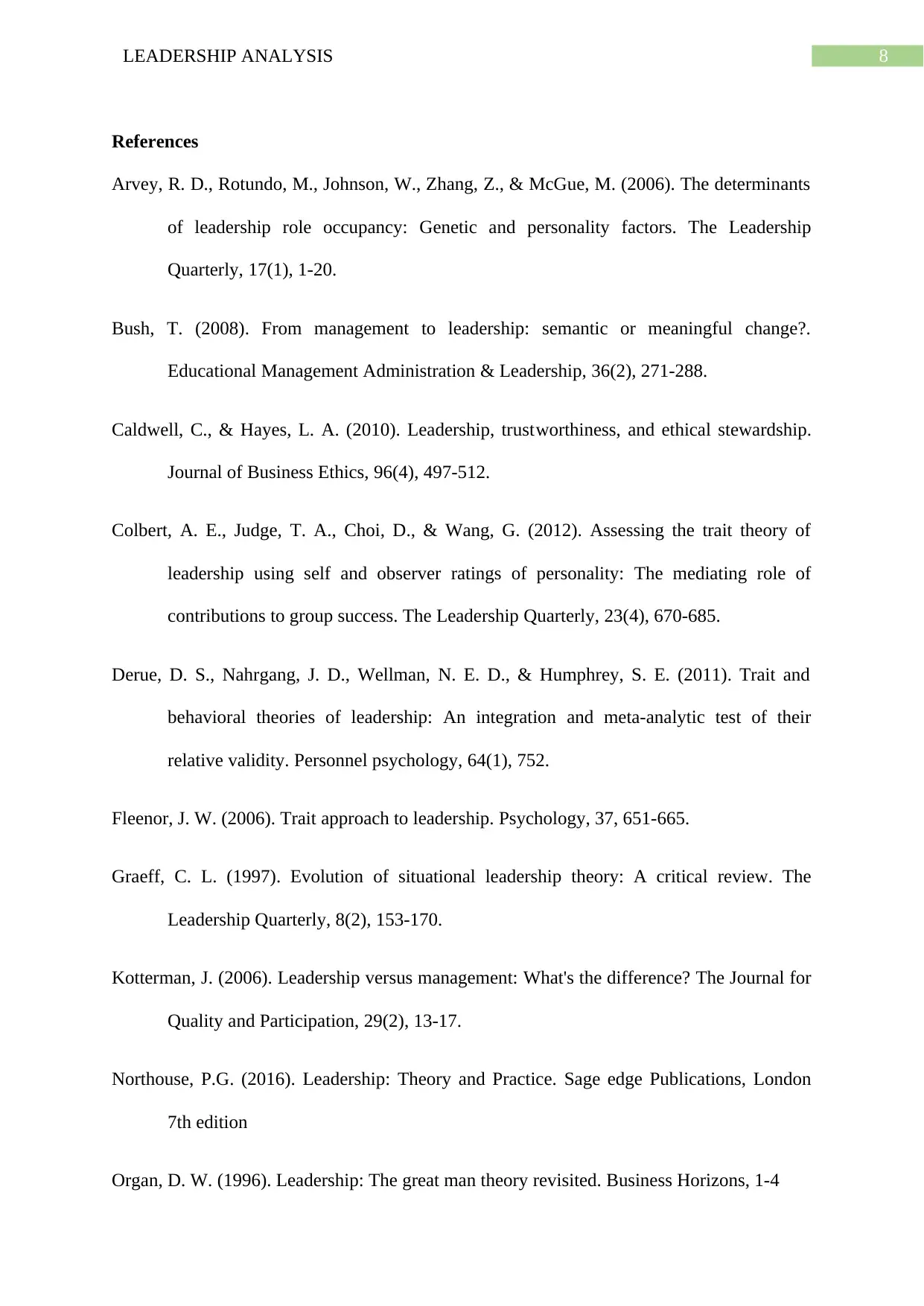
8LEADERSHIP ANALYSIS
References
Arvey, R. D., Rotundo, M., Johnson, W., Zhang, Z., & McGue, M. (2006). The determinants
of leadership role occupancy: Genetic and personality factors. The Leadership
Quarterly, 17(1), 1-20.
Bush, T. (2008). From management to leadership: semantic or meaningful change?.
Educational Management Administration & Leadership, 36(2), 271-288.
Caldwell, C., & Hayes, L. A. (2010). Leadership, trustworthiness, and ethical stewardship.
Journal of Business Ethics, 96(4), 497-512.
Colbert, A. E., Judge, T. A., Choi, D., & Wang, G. (2012). Assessing the trait theory of
leadership using self and observer ratings of personality: The mediating role of
contributions to group success. The Leadership Quarterly, 23(4), 670-685.
Derue, D. S., Nahrgang, J. D., Wellman, N. E. D., & Humphrey, S. E. (2011). Trait and
behavioral theories of leadership: An integration and meta‐analytic test of their
relative validity. Personnel psychology, 64(1), 752.
Fleenor, J. W. (2006). Trait approach to leadership. Psychology, 37, 651-665.
Graeff, C. L. (1997). Evolution of situational leadership theory: A critical review. The
Leadership Quarterly, 8(2), 153-170.
Kotterman, J. (2006). Leadership versus management: What's the difference? The Journal for
Quality and Participation, 29(2), 13-17.
Northouse, P.G. (2016). Leadership: Theory and Practice. Sage edge Publications, London
7th edition
Organ, D. W. (1996). Leadership: The great man theory revisited. Business Horizons, 1-4
References
Arvey, R. D., Rotundo, M., Johnson, W., Zhang, Z., & McGue, M. (2006). The determinants
of leadership role occupancy: Genetic and personality factors. The Leadership
Quarterly, 17(1), 1-20.
Bush, T. (2008). From management to leadership: semantic or meaningful change?.
Educational Management Administration & Leadership, 36(2), 271-288.
Caldwell, C., & Hayes, L. A. (2010). Leadership, trustworthiness, and ethical stewardship.
Journal of Business Ethics, 96(4), 497-512.
Colbert, A. E., Judge, T. A., Choi, D., & Wang, G. (2012). Assessing the trait theory of
leadership using self and observer ratings of personality: The mediating role of
contributions to group success. The Leadership Quarterly, 23(4), 670-685.
Derue, D. S., Nahrgang, J. D., Wellman, N. E. D., & Humphrey, S. E. (2011). Trait and
behavioral theories of leadership: An integration and meta‐analytic test of their
relative validity. Personnel psychology, 64(1), 752.
Fleenor, J. W. (2006). Trait approach to leadership. Psychology, 37, 651-665.
Graeff, C. L. (1997). Evolution of situational leadership theory: A critical review. The
Leadership Quarterly, 8(2), 153-170.
Kotterman, J. (2006). Leadership versus management: What's the difference? The Journal for
Quality and Participation, 29(2), 13-17.
Northouse, P.G. (2016). Leadership: Theory and Practice. Sage edge Publications, London
7th edition
Organ, D. W. (1996). Leadership: The great man theory revisited. Business Horizons, 1-4
⊘ This is a preview!⊘
Do you want full access?
Subscribe today to unlock all pages.

Trusted by 1+ million students worldwide
1 out of 9
Related Documents
Your All-in-One AI-Powered Toolkit for Academic Success.
+13062052269
info@desklib.com
Available 24*7 on WhatsApp / Email
![[object Object]](/_next/static/media/star-bottom.7253800d.svg)
Unlock your academic potential
Copyright © 2020–2025 A2Z Services. All Rights Reserved. Developed and managed by ZUCOL.





